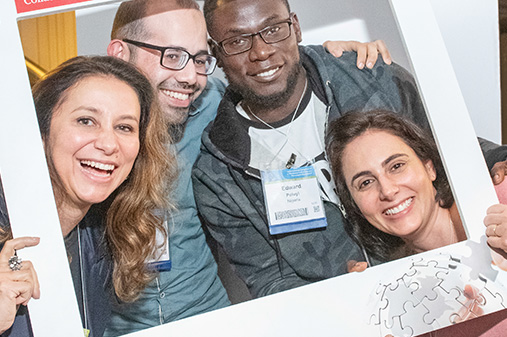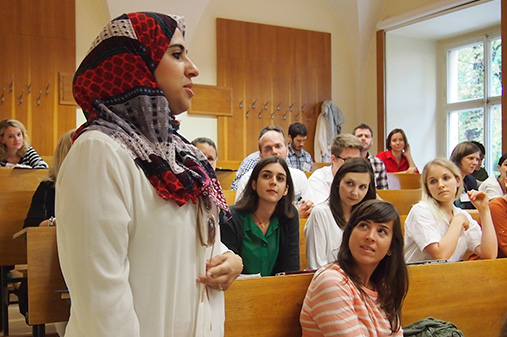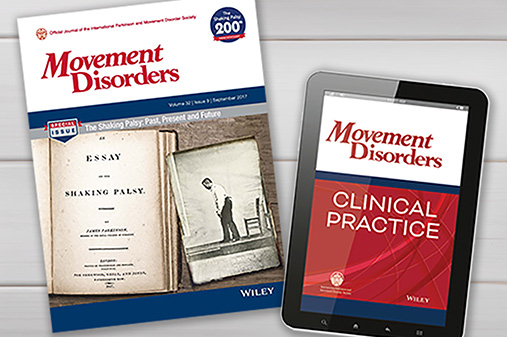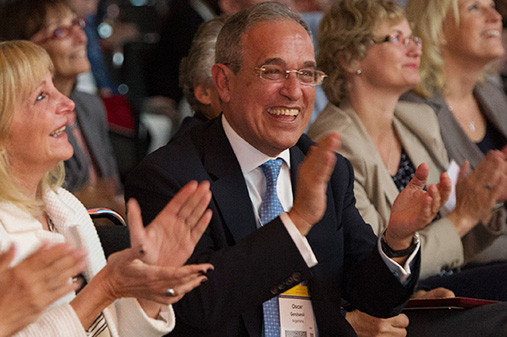Surprise neuropathological findings in LRRK2 mutation carriers
Read the first article.
Read the second article.
Prof. Tiago Outeiro: Hello and welcome to the MDS Podcast, the podcast channel of the International Parkinson and Movement Disorder Society. I'm Tiago Outeiro, a professor at the University Medical Center Göttingen and in Germany. And today I have the pleasure of interviewing Dr. Hiroaki Sekiya from Mayo Clinic, Jacksonville in Florida and Dr. Nanna Jensen from Aarhus University in Denmark. They recently published two important studies in Acta Neuropathologica on neuropathological studies of brains from LRRK2 patients. So welcome both to the MDS podcast. It's a great pleasure to have you with us and cover these exciting findings that you recently published.
View complete transcript
So your studies. Shed some new light into this intriguing observation that Lewy body pathology is not always present in some genetic forms of Parkinson's disease. So I find your studies really important and I would like to ask Dr. [00:01:00] Sekiya. So what tissue did you use in your study?
Dr. Hiroaki Sekiya: Yeah, thank you for this opportunity. So in this study we used 14 brain samples from patients with LRRK2-related Parkinson's disease. And five controls subjects, and we included three LRRK2 mutations, five G2019S cases, five I2020T, and four R1441C cases.
Prof. Tiago Outeiro: Okay, and what about you, Dr. Jensen?
Dr. Nanna Møller Jensen: So in our study we included six LRRK2 cases, all of them negative for Lewy body pathology and compared them to five idiopathic Parkinson's disease cases and six non neurodegenerative controls.
Prof. Tiago Outeiro: And what methods did you use in your study and why? May we start with Dr. Jensen.
Dr. Nanna Møller Jensen: So we used an alpha-synuclein proximity ligation assay with the aggregate [00:02:00] specific antibody Michael J. Fox R14, because it's been shown that proximity ligation assays have an ability to detect very small or very sparse alpha synuclein aggregates that are not being labeled if you do a regular immunohistochemistry.
Prof. Tiago Outeiro: And what about you, Dr. Sekiya?
Dr. Hiroaki Sekiya: Yeah. Similarly, we used alpha-synuclein proximity ligation assay staining. The difference is we used SYN201 synuclein antibody. And the reason for this methodology is that this method specifically enabled to detect synuclein oligomers that are aggregated synuclein.
Prof. Tiago Outeiro: Yeah. And so it's quite amazing that in two groups independently you chose to use this same method, same technology. So what is the advantage of using this type of [00:03:00] technology? Maybe Dr. Jensen, do you want to address this?
Dr. Nanna Møller Jensen: So the advantage of the proximity ligation assay is that it's very sensitive. It has a very high signal to noise ratio because it does an amplification step in the reaction. So you have the specificity from the antibodies you use, but then you amplify the signal in a way that really allows you to detect these very small oligomeric aggregates of alpha synuclein.
Prof. Tiago Outeiro: And what did you find in your study, Dr. Sekiya?
Dr. Hiroaki Sekiya: So in our study we found abundant distribution of alpha-synuclein oligomers in all patients regardless of the presence of Lewy-related pathology. There are a lot of synuclein oligomers even in cases without Lewy-related pathology.
Prof. Tiago Outeiro: And in your study, Dr. Jensen.
Dr. Nanna Møller Jensen: So we basically had the same observation as Dr. Sekiya's group, [00:04:00] when we looked at the brains of these LRRK2 cases, even though they did not have Lewy pathology, they had a lot of alpha synuclein PLA signal that we believe stem from alpha synuclein oligomers maybe protofibrils, or at least some sort of alpha synuclein aggregates that are not being organized into a Lewy body.
Prof. Tiago Outeiro: Yeah. 'Cause we know we've known for a while that there is some other genetic forms of Parkinson's that are also seem to be negative for Lewy body pathology. So are you studying any of these other genetic forms, like PRKN cases using the same technology, is that something you are considering?
Dr. Jensen, you can start.
Dr. Nanna Møller Jensen: So it's definitely something that we're considering and we have established a collaboration with a group in Japan who has access to some of these cases. At present, we don't have any results to share so far , so nothing concrete yet, but [00:05:00] it's definitely based on the observations from our current studies with the LRRK2 cases, very intriguing thing to also study these PRKN cases or other cases where Lewy pathology is not universal.
Prof. Tiago Outeiro: And what about you, Dr. Sekiya? Do you have anything to share about these other genetic forms of Parkinson's? Are you looking into them as well?
Dr. Hiroaki Sekiya: Yes, now we are thinking to do the similar investigation to those cases, but not yet done. Yeah, I'm looking forward to share the interesting observations if I can get some.
Prof. Tiago Outeiro: Yeah. And of course now we talk a lot about biomarkers and the alpha-synuclein seeding amplification assay. So do you have data to correlate your findings with seeding amplification data in the same patients? I don't know. Dr. Sekiya, do you want to start.
Dr. Hiroaki Sekiya: So not yet [00:06:00] completed as well, but yeah now the next step should include such lesson to detect the seeding amplification activity in those patients.
Prof. Tiago Outeiro: Yeah. And what about you, Dr. Jensen?
Dr. Nanna Møller Jensen: At present, we do not have any seeding amplification assay data on the LRRK2 cases that we've studied in this project. But it's definitely on the horizon for us as well to look into the correlation between the alpha synuclein PLA and the seeding amplification assay. There was a study last year by an Italian group where they showed that when they looked at the seeding activity in brain homogenates from Parkinson's disease cases, they could see seeding activity even in the absence of Lewy pathology in the same brain regions, and that's definitely something that makes me think that maybe these PLA [00:07:00] positive species could be something that would seed in the SAA.
Prof. Tiago Outeiro: So you would expect some seeding activity at least. But we also know that there are some cases that are negative in the seeding activity. So do you think they would have different types of species that are not even detected by the PLA or how would one i nterpret those.
Dr. Nanna Møller Jensen: I think there are, at least a couple of different ways to interpret it. For one thing, when you look at the CSF samples, I think that we know very little about which brain regions release aggregates into the CSF. To what degree and at what point in disease do you need to reach a certain amount of disease in a region before it starts releasing it into the CSF?
And there is some indication that if you have very focal pathology in the brain, then you're likely to be negative on the CSF seeding amplification assay. [00:08:00] But it might indeed also be that there are some species that may be detected by the PLA but are very bad at seeding and thus won't result in a positive seeding amplification assay result.
Prof. Tiago Outeiro: Yeah. And Dr. Sekiya are you thinking of using this type of approach in non CNS tissue? For example, gut tissue as well to see if you detect similar species there as well?
Dr. Hiroaki Sekiya: Yeah, that's a very good question. Actually we don't have a lot of tissue besides brain samples. So we haven't tried the method to other peripheral tissues yet. But yeah, it sounds very interesting to conduct the study using the, like guts or other tissues. And we might find a very interesting observation that originate the synuclein pathology first.
Prof. Tiago Outeiro: Yeah. and [00:09:00] finally, so these are very nice studies. Of course, we know science is never, the end of the road. It's always the middle of the road, what are the limitations of your studies? I want to hear from each of you and what are the next steps in each of your groups?
Dr. Nanna Møller Jensen: So the study is of course limited by the number of samples that we have included. So it is only six of these LRRK2 cases that we have examined, and that's of course a very low number. So to generalize and say that this is something that's valid for all LRRK2 cases who do not show Lewy pathology is probably to take it a step too far, we really need to look into more cases.
And then as you said also and brought up with the seeding amplification assay or other methods of looking at alpha-synuclein aggregates. We do not know that much about how the alpha-synuclein PLA results [00:10:00] correlate with these other analysis. And we really need to understand that further. Then another observation that we had in our cohort was that a few of the controls that we included actually also showed relatively high amounts of alpha synuclein PLA signal, and we need to figure out if that means that these, controls are actually preclinical cases of Parkinson's disease that just did not have major symptomatology and therefore hadn't been diagnosed at the time of death, which would be likely since both our studies show that the alpha synuclein PLA can detect aggregate species that appear before the Lewy bodies do in the disease course, but it might also be that maybe there's just, some brain regions that are likely to generate low levels of alpha synuclein aggregates, even in healthy people, but they're [00:11:00] just usually being degraded at a constant rate. That means that they do not accumulate at a point where they become problem. And that's a lot there that we still need to understand regarding the alpha synuclein PLA. Regarding our future perspectives on this research. As you also mentioned earlier, biomarkers is really something that the field needs. And of course, with all this research being based on post-mortem brain samples, the alpha synuclein PLA is not yet at least proved to be a very good, valid biomarker. We are really interested in looking into whether we can use peripheral tissues or fluid samples and adopt the PLA to detect something in living patients that we could use as a biomarker of disease progression.
Prof. Tiago Outeiro: Yeah. And [00:12:00] Dr. Sekiya what do you think are the major limitations in your study and what are the next steps ahead of you?
Dr. Hiroaki Sekiya: So, Yeah, similar, but the limitation is of course our relatively small sample size, even though we included 14 patients. So given the reality of the LRRK2 mutation cases, it's not so small, but still relatively small. So we need more cases to confirm our findings and at the same time, the method, theoretically, we can detect signals if the synuclein molecules are two or more, but we don't know exactly how big the molecules I don't know. So that major limitation of our methodology. And at the same time we want to understand when the earliest formation of such pathological oligomers in the brain. So if we have some chance to access the brain tissue with mutation carriers aiming [00:13:00] by asymptomatic mutation carrier. It might be very interesting to understand when such pathological formation pathological oligomers begin.
And that leads to the therapeutic strategy. When is the best timing to start or think the therapeutic intervention in those mutation carriers?
So, LRRK2 is indeed associated with familial form of Parkinson disease. Also it associated with sporadic Parkinson.
Our findings might be expanded to sporadic Parkinson disease patient as well. So this is another interesting and important insight.
Prof. Tiago Outeiro: Yeah, so I really see this novel findings may have broad implications for the field, at least for the way we interpret the relevance of Lewy bodies and for how we follow disease progression. So I'm very excited. I'm very happy we had a chance to talk. And is there anything else you [00:14:00] would like to highlight regarding your studies, Dr. Jensen?
Dr. Nanna Møller Jensen: I think it's an important point that you brought up we have to look at Lewy pathology in a new way, and we have to try to understand what actually governs. Whether you can form a Lewy body even because for a long time people have thought that maybe these two cases that do not show Lewy pathology, maybe there's simply no alpha synuclein aggregation in them.
Maybe alpha synuclein does not play any role at all in their disease. Our studies show that this is probably not the case. It seems to instead be, because t hese cases, for some reason, that we do not understand, have alpha synuclein aggregates that are just not being organized into Lewy bodies. So for some reason, the cell cannot make a Lewy body, and we don't understand why this happens, we have no idea what it actually means for the [00:15:00] disease either.
Is it better or worse to have Parkinson's disease without Lewy bodies? So I think that's an interesting point to study further as well.
Prof. Tiago Outeiro: Yeah. Yeah, I was just thinking here that we tend to think of multiple system atrophy as a disease where you have synuclein accumulation in oligodendroglial cells. But I wonder if we have synuclein oligomers that are not Lewy body pathology, but present in neurons as well, in MSA. I don't know.
What do you think Dr. Sekiya?
Dr. Hiroaki Sekiya: It's very important. Yeah. Because we have reviewed distribution of oligomers in multiple system atrophy as well, before. Yeah, we believe the such toxic species of synuclein, aggregates might play an important role in the pathogenicity of alpha synucleinopathy. At the same time we observed in the present study, we observed the negative correlation between the abundance of [00:16:00] synuclein oligomers and gradient pathology.
So we believe there should be a kind temporal shift of alpha synuclein aggregates in alpha synucleinopathy, first are forms synuclein oligomers, but when the gradient pathology begins to form synuclein pieces or molecules get pulled into the pathology, and so the synuclein oligomers decrease, so this is dynamic mechanism of the synuclein aggregates. And perhaps the gradient pathology has some protective effect to separate the toxic species of synuclein inside. So this is a very interesting topic to understand.
Prof. Tiago Outeiro: Great. Thank you so much. I think we covered a lot of ground. I hope our listeners enjoy the conversation and maybe this will help them also. Develop their own thoughts about how to think and interpret all of these very exciting findings. So I want to thank you [00:17:00] both. It was a pleasure, and I look forward to reading about your next studies.
Dr. Nanna Møller Jensen: Thank you so much.
Prof. Tiago Outeiro: So we've just interviewed Dr. Jensen and Dr. Sekiya about their recent publications in Acta Neuropathologica on the neuropathology of LRRK2 associated Parkinson's disease cases. Thank you all for listening and join us in our upcoming podcasts.

Hiroaki Sekiya, MD, PhD
Department of Neuroscience
Mayo Clinic
Jacksonville, FL, USA

Nanna Møller Jensen, PhD
DANDRITE, Dept. of Biomedicine
Aarhus University
Aarhus, Denmark









